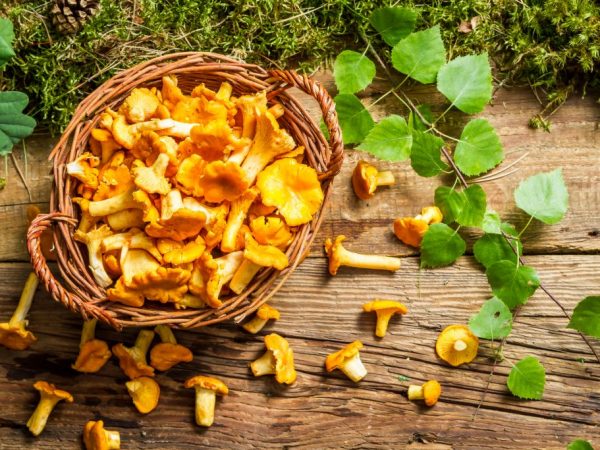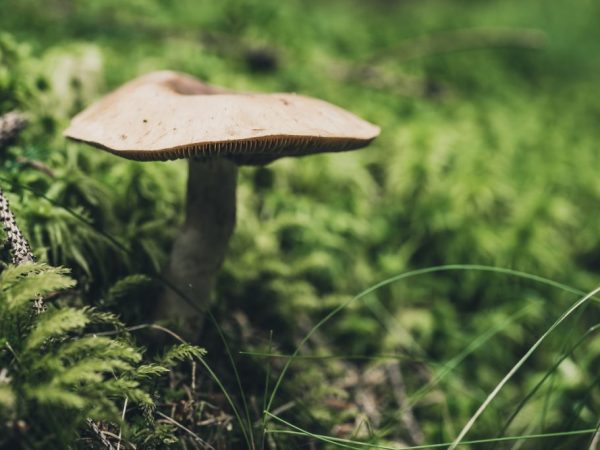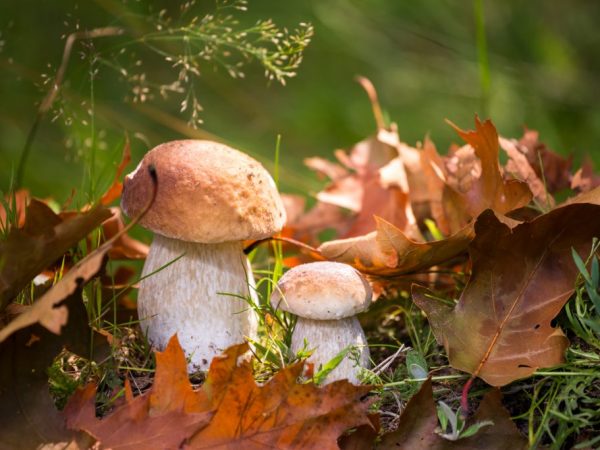Mushrooms in August 2019
August is a good time for mushroom pickers. Mushrooms in August 2019 will grow in large numbers and varieties. Studying the characteristics of their growth, depending on the region, will prepare mushroom pickers for harvesting.

Mushrooms in August 2019
Mushrooms of august
August 2019 is a busy period for the growth of various types of mushrooms. Grow in season:
- boletus, white;
- chanterelles;
- mushrooms;
- waves;
- honey agarics;
- milk mushrooms;
- flywheels;
- redheads, boletuses;
- base supports;
- russula.
Honey mushrooms
If a couple of honey agarics has appeared, it is worth looking further: they grow in groups. They are used for pickling and frying. It is worth collecting this mushroom carefully, since there are false pigs or false honey agarics. They have a color from gray-yellow to brick-red, there are no scales, rings on the legs, they smell bad.
In order for children to better remember what are the differences between real and false agarics, you can learn the quatrain with them:
Have an edible mushroom
There is a film ring on the leg.
And all false honey agarics
Legs are bare to the toes.
Boletus, porcini mushrooms
Boletus in translation means "a mushroom growing in coniferous forests - pine forests". White mushroom is a representative of a species of the Boletovye family, this is the second name for boletus.
In porcini mushrooms, the cap is of different colors, it can be from dark brown to light, it depends on the place of their growth. White dense pulp does not change its color with different types of workpieces. They can be dried, salted, fried.
Ryzhiki
Ginger has a great taste. He lives in places where spruce grows. Its flesh is bright orange, the color turns blue on the cut. The leg is short.
Irina Selyutina (Biologist):
Camelina mushrooms are characterized by their own parasitic fungi. Representatives of the brick-red Pekiella species, belonging to the Hypomyceteaceous family, often settle on their fruit bodies. During its development, its mycelium causes a reduction of the hymenophore plates and almost completely covers the entire underside of the cap of the saffron milk cap. Lovers of "quiet hunting" call such mushrooms "stone" or "deaf". Mycologists say that the plates in this case lose the ability to form spores. Mushroom pickers and experts agree on the nutritional value - picking such mushrooms is not recommended.
Before cooking, mushrooms do not require cooking, they only need soaking.
Milk mushrooms
The mushrooms are characterized by a funnel-shaped cap of a whitish color, a light-colored leg in the shape of a cylinder. Milk mushrooms are used for pickles.
Chanterelles
Chanterelles are not wormy, they grow on the territory of coniferous, birch, mixed forests.
Irina Selyutina (Biologist):
Among fans of mushrooming, chanterelles are highly valued for their excellent taste and the almost complete absence of insect larvae (which we more commonly call "worms") in the fruit bodies. This is due to the presence in the pulp of a special compound - chinomannose, which is a natural shield of the fungus from parasites (antihelmintic) that seek to feast on it.
The spore-bearing layer of the chanterelle consists of pseudoplates - thick, sparse and branched folds, of the same color as the cap, which descend along the stalk and blur the border between it and the cap. It is this and the peculiarity of the formation of spores that served as the basis for the allocation of chanterelles to the Chanterelle family
Volnushki
Usually mushroom pickers collect white and pink waves.
The pink flower has a lot of synonyms:
- volzhanka;
- wave;
- broth;
- roe;
- volnyanka.
These mushrooms are common on mosses, in swampy areas, in shaded areas. The wave has a pink hat, its height is 5-7 cm, a leg is 2 cm in diameter. In the middle of the hat there is a depression, which disappears as it grows.
White wave, or as it is also called - white, volzhanka, grows among birches, its height reaches 4 cm. A hat with a depressed center. The color is dark in the middle, light at the edges. The crop is harvested since August.
Flywheels

Flywheels taste great
Mosswheel is a category 3 edible mushroom with excellent taste. Flywheels are boiled, canned, fried, pickled, dried. The moss grows along roads, at the edges of forests and among bushes.
Boletus (redheads)
Boletus boletuses have a bright orange cap and grow in mixed forests next to aspen trees, they taste good and are used for boiling, frying, drying and pickling.
Bearings
The leaflet belongs to russula, it is called:
- thresher;
- spurge;
- the lump is red-brown.
The base has a dense cap with a diameter of up to 10 cm, it is flat in shape, and tends to crack. The color of the cap ranges from red to yellow-brown.
The pulp is white, fleshy, dense. Its smell is described in different ways: to someone it resembles a herring, to someone the smell of pear flowers, and someone does not feel it at all. When cut, a white milky sap is released, which turns brown and thickens in air.
Russula
Russula are a common type of edible mushroom that grows in deciduous, coniferous forests. The collection starts in August.
Mushroom growth geography
August 2019 will bring excellent mushroom picking, depending on the territory of the country.
Vladimir region
The Vladimir region in 2019 will open the picking season for the following mushrooms:
- boletus;
- aspen mushrooms;
- boletus;
- mushrooms;
- white;
- value;
- flywheels;
- waves;
- mushrooms;
- russula.
It is worth collecting them in the area with caution, because poisonous species also grow here: pale grebe, fly agarics, tinder fungi.
In the region, there are cases of poisoning with ryadovki and russula, which novice mushroom pickers often confuse with champignons. Therefore, experienced mushroom eaters recommend that you first carefully study the atlas with a photo and a detailed description of the types of mushrooms, and only then go to the forest for mushrooms.
Tver region

Mushroom yield depends on the weather
August is the mushroom season in Tver. The Tver region is rich in the following species:
- honey agarics;
- russula;
- chanterelles;
- aspen mushrooms;
- boletus;
- white.
The number of mushrooms and their varieties depends on the weather conditions. If there were heavy rains before August, the yield increases. Experienced lovers of "quiet hunting" are sure that stubs can be found in their area almost at any time of the year, except for the winter months.
Leningrad region
The Leningrad region in August 2019 will bring a rich mushroom harvest. On its territory there are:
- White mushrooms;
- chanterelles;
- flywheels;
- loading;
- aspen mushrooms;
- boletus;
- russula;
- boletus.
Depending on the variety, they build a mushroom picking route in the Leningrad Region. Whites are harvested in Kirillovsky, Gavrilovo, Tarasovsky, Zakhodsky, aspen mushrooms - in Roshchino, Losevo, Sosnovo, chanterelles, russula, boletus, boletus - in Snegirevka, boletus - in Losevo, boletus - in Kirillovsky, around Yagodnoye.
Tula region
August is the mushroom season in the Tula region, on its territory grow:
- milk mushrooms;
- boletus;
- boletus;
- waves;
- boletus;
- aspen mushrooms.
Places for a hike should be chosen based on the search for the desired type of mushrooms. Mushroom sites are located near Suvorov, Aleksin, Odoevsky, Dubensky districts.
Previously, the inhabitants of the region collected pigs in large quantities. Now, when doctors began to warn about its hidden harm to health due to the presence of a small percentage of toxins that can accumulate for a long time (not excreted!) In the human body, those who want to start collecting these conditionally edible mushrooms have significantly diminished.
Sverdlovsk region
Different species grow here:
- in forests with needles, foliage - russula, honey agarics, boletus, boletus, milk mushrooms, mushrooms, white;
- in damp meadow forests - boletus (boletus, boletus);
- in the lowland forests - mushrooms, greenfinches, umbrella mushrooms.
Various species come to Yekaterinburg from the southern regions of the Sverdlovsk region: Krasnoufimsky, Artinsky, Sysertsky, etc.
For a number of years now, mushroom pickers of the Sverdlovsk Region have traditionally divided mushrooms into:
- tasty and aromatic (white, mushrooms, milk mushrooms, mushrooms);
- less tasty (boletus, morels, chanterelles);
- conditionally edible (take if there is nothing else).
Voronezh region
Voronezh and the areas around it have a variety of mushrooms. Here grow:
- boletus;
- rows;
- honey agarics;
- boletus;
- white;
- aspen mushrooms;
- greenfinches.
So that novice mushroom pickers do not return home with empty baskets, experienced mushroom pickers advise them to go mushroom picking in the fall.
Mushroom lifespan
Within 24 hours, mushrooms grow by an average of 1-2 cm. Honey mushrooms, boletus, chanterelles grow for 10 days, aspen boletus, porcini mushroom, champignons live for 2 weeks - about 40 days.
Conclusion
August 2019 predicts an abundance of different types of mushrooms. For the collection it is worth choosing the right place. It is necessary to collect mushrooms carefully, because along with edible mushrooms, there are also poisonous species in the forest, whose representatives outwardly resemble tasty and healthy specimens.



